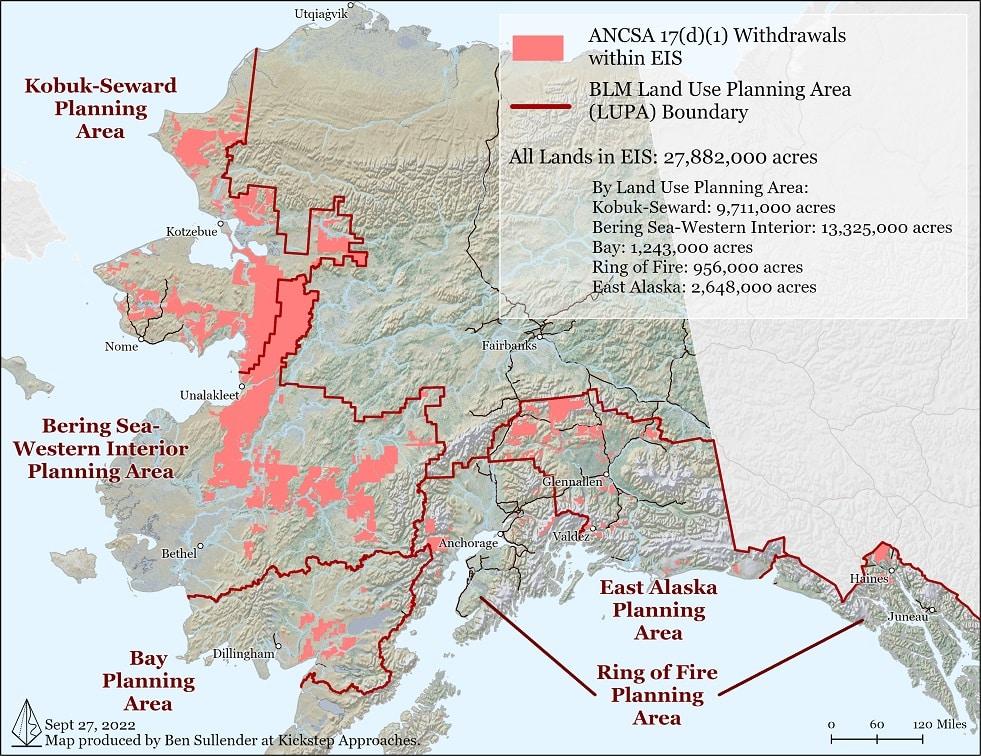
Why you should care about D1 lands in Alaska
By Dawnell Smith
Maybe you’ve heard the term “D1” in sports (division 1) or in construction (course gravel material), but “D1” means something quite different when talking about land in Alaska.
Here, D1 lands refer to areas protected from mining and mineral leasing since the 1970s. They are commonly called D1 lands because they were withdrawn pursuant to section 17(d)(1) of the Alaska Native Claims Settlement Act.

That section of ANCSA gave the Interior Secretary authority to determine whether any portion of those lands should be withdrawn in the public interest—to protect food access and cultural relationships with the land, for example, and to ensure the health of animals and their habitat. Over 50 years ago, the Secretary withdrew more than 158 million acres of these lands and protected them from fossil fuel and mining leasing and extraction.
Why are we talking about these lands now?
The short answer is that last year the U.S. Bureau of Land Management issued a notice of intent to prepare an environmental impact statement to consider opening nearly 28 million acres of these lands across the state to leasing—potentially expanding industrialization on lands important to the health of ecosystems, animals, recreational areas, and local communities.
The land is whole
When governing bodies put arbitrary boundaries around places and decide and define what those places can be used for, they presume what interests get priority. They presume concepts like “ownership” and “entitlement.”
Under this structure, the “reserving” of federal public lands presumes the appropriation of them to industry and private interests. “Withdrawing” lands from this presumption and holding them as “unreserved” means not appropriating them and instead protecting them from extraction, industrialization, and privatization. That’s what the secretary of Interior did in the mid-70s.
The Bush administration and later the Trump administration made it part of their agenda to open D1 lands to oil and gas, mining, and other corporate and private interests. The Trump-era effort involved issuing five public land orders lifting withdrawals on nearly 28 million acres across five planning areas in Alaska—the Bay, Bering Sea-Western Interior, East Alaska, Kobuk-Seward Peninsula, and Ring of Fire planning areas.
These orders never went into effect and the Biden administration later determined they were legally flawed. They have not been rescinded, however. Instead, the U.S. Bureau of Land Management recently issued that notice of intent to consider the impacts of opening 28 million acres of D1 lands pursuant to the Trump-era public land orders in 2022.
The current lay of the land
That October, we joined in submitting a comment letter to the Bureau of Land Management urging the agency to rescind the Trump-era PLOs and retain withdrawals across all 28 million acres. We asked that the agency look at and include in its environmental review the significant and expansive impacts of opening D1 lands to extraction and industrialization. We specifically noted that the interconnected landscapes in question “support terrestrial mammals, birds, aquatic life, wild food economies, and traditions and cultures across wide areas of the state.” There are an array of climate and biodiversity concerns with profound implications for the future of Alaska, animal species, and the planet.
We expect the agency’s draft environmental impact statement to come out in the fall, with opportunities for public comment.
We will remain focused on this process and engage in every way possible to prevent the pollution, degradation, and destruction of lands important to Alaska’s animal life, human communities and cultures, and future generations.
We encourage you to stay engaged, too, and will keep you updated in the months to come.


